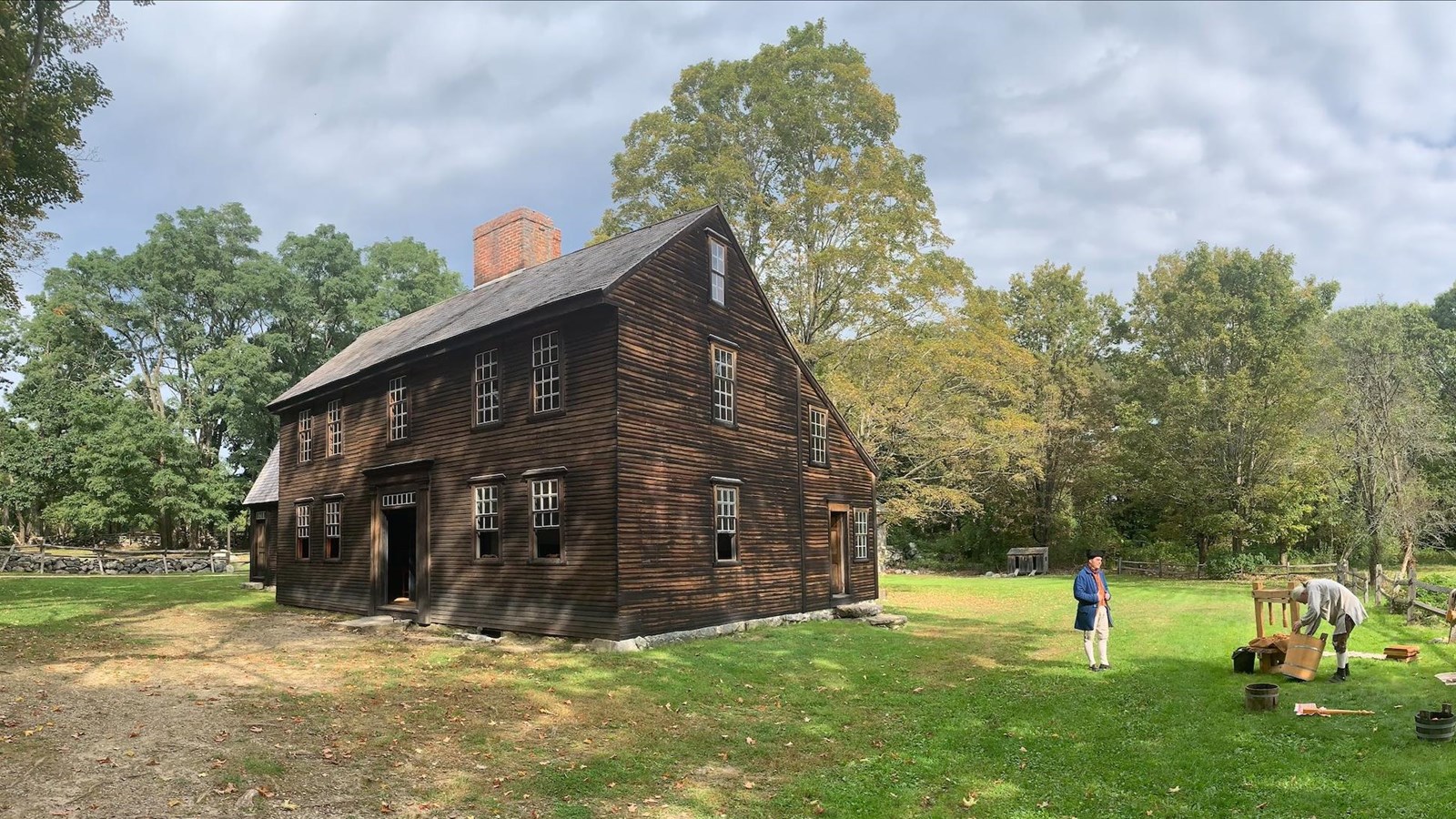Last updated: January 17, 2023
Place
Hartwell Tavern, 1733

NPS Photo
Benches/Seating, Bicycle - Rack, Historical/Interpretive Information/Exhibits, Information, Information - Maps Available, Information - Ranger/Staff Member Present, Information Kiosk/Bulletin Board, Parking - Auto, Parking - Bus/RV, Restroom - Seasonal, Scenic View/Photo Spot, Trailhead, Water - Drinking/Potable
Battle Road Map
An interactive map of Battle Road, April 19, 1775
When Ephraim and Elizabeth Hartwell married, Ephraim's father Samuel gave the couple a new house (built 1732-1733) surrounded by 18 acres of land and 12 additional acres (30 acres total) to start their family. Although later referred to as Hartwell Tavern, the house originally acted as a family residence and farmhouse until Ephraim applied for an innkeeper license in 1756. For over thirty years the Hartwell's ran an "ordinary" tavern out of their home until 1787.
During the late 18th century, the Hartwell's became one of the wealthiest families in the town of Lincoln. In total Ephraim and Elizabeth had 14 children, nine of which survived to adulthood.
The Hartwell family also enslaved one woman named Violet, however little information is yet known about Violet's story. It is presumed Violet experienced the events of April 19, 1775 however little information currently documents her narrative.
The house continued to be a residence until it was purchased by the National Park Service in 1967.
Hartwell Tavern On April 19, 1775
In 1775 Hartwell Tavern sat on the main road, the "Bay Road," running from Boston through western Massachusetts to Crown Point, N.Y. This was the road that British troops used on their way to find and destroy colonial military stockpiles in Concord.
On the night of April 18th, 1775 an advance guard of British soldiers captured colonial alarm rider Paul Revere just down the road from the tavern. Dr. Samuel Prescott of Concord, who was riding with Paul Revere and William Dawes, escaped by leaping his horse over a stone wall and fleeing through pasture and swamp. Prescott re-entered the main road near Hartwell Tavern and alerted the family who in turn spread the alarm of the British military expedition to their neighbors, including William Smith, Captain of the Lincoln minute man company.
Three of Ephraim and Elizabeth Hartwell's sons answered the alarm as Minute Men that morning. Samuel (age 33) and John (age 28) were both sergeants, and Isaac (23) was a private: All three went on to later military service in the Revolutionary War. -- Massachusetts Soldiers & Sailors of the Revolutionary War, Boston, 1900, pp.393-396.
Later in the morning, the British column passed by the tavern on their way to Concord. Mary Hartwell, daughter-in-law to Ephraim and Elizabeth recalled the massive column of soldiers, bayonets fixed, marching through the area. It is believed after the soldiers passed, the remaining Hartwell's fled to a safer location away from the road.
The Lincoln Minute Men fought the British column at Concord's North Bridge that morning and then again along the battle road that afternoon. When the British soldiers exited Concord around 12:30 p.m. Capt. Smith's company engaged. With thousand's of militia soldiers pouring into the fight from surrounding towns, combat spread along the Bay Road from Concord and eventually into the fields surrounding Hartwell Tavern. As the British soldiers attempted to escape, militia fired on the column from behind every boulder, stone wall, and tree. Near Hartwell Tavern, British soldiers killed three colonial militia behind a barn, however many British regulars were also wounded or killed in the surrounding area.
There are no records or stories about soldiers entering the tavern for any reason, but still, the Hartwell family returned home late on April 19, 1775 to a horrific landscape. Mary Hartwell recalled she could scarcely sleep that night knowing dead men lay strewn along the road. According to local tradition, the next morning Ephraim Hartwell hitched his team of oxen to a cart and scoured his property collecting the dead British soldiers left behind. In total the Hartwell family helped collect five British soldiers killed near their home and buried them in the Lincoln town burial ground.
At the end of April 19, 1775, the siege of Boston and the American Revolution had begun. All Hartwell sons survived their experience as Minute Men and entered service in the Massachusettus army thereafter.
Restoration
During it's long history, Hartwell Tavern was modified and modernized. In the 1980's, the Park Service restored the structure to its 1775 appearance, however keeping its 1783 and 1830 additions. The main structure, the foundation, most of the walls, and some of the flooring are original.
Preservationists removed the modern exterior clapboarding and replaced it with clapboarding made in the same way that 18th c. clapboarding was made.
Many of the windows have original 18th c. glass salvaged from other houses being demolished, and pieced into reproduction window frames. The nails are hand wrought by modern blacksmiths using traditional techniques, as were the iron latches, hinges, etc. made by the blacksmith at Saugus Ironworks NHS.
During restoration, workers found the remains of original 18th century plastering in every room except the tavern room. In addition, 18th century paint found underneath modern layers of paint and wallpaper informed workers of original colors. Using these discoveries the teams restored the rooms as they originally looked in the 18th century.
In all, about 60 - 70 % of the "original" structure remains within the restored house.
